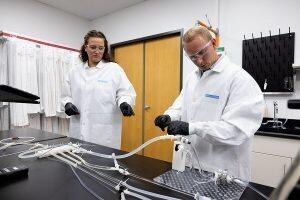Particulate Matter Testing
Testing Services
Particulate matter testing includes procedures for removing, counting, and sizing particulate. Our testing regimen for medical devices that require particulate matter testing has been designed to collect and measure particulates that are released from devices during simulated deployment and tracking, within an injection, or what may be generated under multiple fatigue models. The model development and associated spiking and recovery validations we perform are ideal for a robust particulate method that will stand up during a design review, manufacturing change or regulatory clearance. In addition to particulate counting and sizing we have the capability to identify the particle composition using our FTIR, SEM and high resolution microscopes.
Counting and sizing of particulate matter under validated procedures are becoming more relevant to medical device development and risk mitigation. Choosing an appropriate validated method with appropriate controls such as spiking and recovery with traceable spheres through a physiologically relevant anatomy is very important during a regulatory submission. Overall, this test can be useful to determine the amount of particulate matter within a given manufacturing process, validating other preclinical events or to determine the acceptable amount of particulates removed during use.
Acute Particulate Testing
The first step in particulate testing is determination of a physiologically relevant model. After selection and justification of your model, appropriate validation steps need to be performed. These can be but are not limited to, spiking and recovery and benchmarking against a known predicate.
Light Obscuration Method: This method allows the ability for the user to identify the particulate matter within a given solution. This method can be utilized with a rinse or be continuously collected during a simulated use procedure. Particle sizes can be binned to determine counts and sizes. Non-uniform particles can be difficult within this method so appropriate validation of your sample is generally a good idea. We typically recommend collecting and microscopically identifying what shapes will be present during particulate counting and sizing.
Microscopic Method: Generally, for larger particles and to validate our light obscuration method, we place in-line filters within the test system to collect any potential particles after they pass through the particulate counters. This helps to identify shape and sizes and further validates the light obscuration method.
Chronic Particulate Testing
The first step in particulate testing is determining appropriate boundary conditions. In the chronic setting vs the acute setting this can be the amount of deformation and the number of cycles the device is expected to encounter clinically. For us, this method was developed as part of the first approved drug coated peripheral stent. We use the same methods to count and size particles as the acute particulate testing method. We look forward to helping you through study design and execution.
Our Method
Our lab is ISO/IEC 17025:2017 accredited for particulate matter testing. We perform both acute and chronic particulate evaluations in accordance with appropriate ASTM and ISO standards and can accommodate other standards as needed for your device.
TEST METHODS
- Lab Developed Medical Device Testing Method PART-02
- Lab Developed Medical Device Testing Method PART-03
- Lab Developed Medical Device Testing Method PART-04
- Lab Developed Medical Device Testing Method PART-05
ASTM F2394-07 (2017) – Standard Guide for Measuring Securement of Balloon Expandable Vascular Stent Mounted on Delivery System
ISO 25539-2:2012 – Cardiovascular Implants – Endovascular Devices – Part 2: Vascular stents
FDA Guidance for Industry and FDA Staff – Non-Clinical Engineering Tests and Recommended Labeling for Intravascular Stents and Associated Delivery Systems, April 18, 2010
FDA Guidance – Class II Special Controls Guidance Document for Certain Percutaneous Transluminal Angioplasty (PTCA) Catheters
ASTM F2743-11 – Coating Inspection and Acute Particulate Characterization of Coated Drug-Eluting Vascular Stent Systems
AAMI TIR42:2010 – Evaluation of Particulates Associated with Vascular Medical Devices
ASTM WK46148 – Standard Guide for Acute InVitro Evaluation of Drug Coated Balloons
ISO 12417-1:2015 – Cardiovascular Implants and Extracorporeal Systems — Vascular device-drug combination products
ISO/TS 17137:2014 – Cardiovascular implants and extracorporeal systems — Cardiovascular absorbable implants
ASTM F3036-13 – Standard Guide for Testing Absorbable Stents
ASTM WK60510 – New Test Method for Simulated use testing of neurointerventional device in tortuous vasculature
ASTM WK60511 – New Test Method for Particle evaluation and characterization for neurointerventional devices
OUR COMMITMENT
We are committed to consistently performing services with high quality, that deliver exceptional results, and add value to the client’s business.
For client surveys sent in 2024, we received ratings of 4.98/5 points (13).
